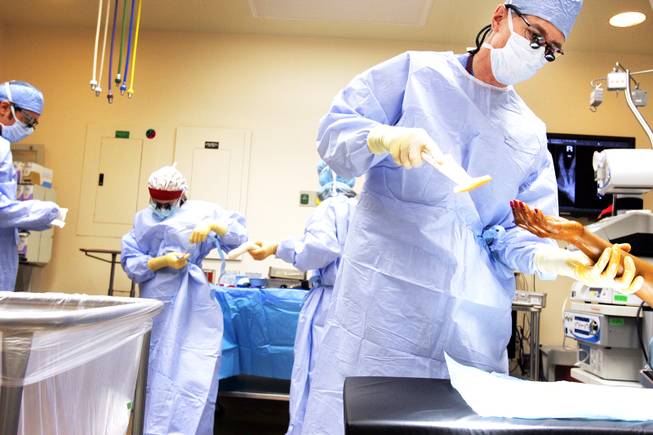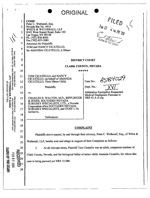
Dr. David Ring prepares a patient for hand surgery at Mass General West in Waltham, Mass., Thursday, March 3, 2011.
Sunday, March 27, 2011 | 2 a.m.
Do No Harm: Hospital Care in Las Vegas, Part 5
- Sun investigation reveals flaws in hospital care; solutions offered
- How to put patients first
- Local hospitals’ willingness to change culture would be a step toward better care, transparency
- ‘You can’t kill my mother and get away with it’
- We must adopt a culture of sincere care
- How to file a complaint
Share your stories
Dr. David Ring had just finished operating on the hand of a 65-year-old woman when he made a discovery that two years later still brings tears to his eyes.
The patient had sought treatment at Massachusetts General Hospital for a condition known as trigger finger — a finger locked in a bent position — but instead Ring performed surgery to correct carpal tunnel syndrome. Referring to her medical file as he began dictating his post-surgical notes, Ring realized his error.
He said it was one of the worst experiences of his life.
Some doctors avoid admitting mistakes — even to their patients — for fear of malpractice lawsuits or the loss of referrals and reputation. But Ring wanted other surgeons to learn from his mistake and the circumstances that contributed to it. So after he made things right with the patient, he wrote up the case in The New England Journal of Medicine, laying out all the details for the world to see.
“Everyone will benefit — the patients first — by being open,” Ring said. “There’s nothing to benefit by hiding or sweeping things under the rug.”
Ring, 43, is an associate professor at Harvard Medical School and board certified in orthopedic and hand surgery. Part of his motivation for making his mistake public was to show it can happen to anyone.
He disclosed the error to the patient, apologizing. Ring got the patient’s consent and performed the correct procedure the same day. But she later lost faith in him and found another doctor for follow-up care. He said he doesn’t blame her. (Her fees were waived, and she later received a financial settlement.)
In the journal article, Ring recounted the confusion in the operating room that day:
• The nurse marked the correct arm to be operated on, but not the incision site.
• Stress was high because several surgeons were behind schedule.
• The patient was moved into a different operating room, so the nurse who prepared the patient for surgery was not present for the procedure.
• A tourniquet was missing from the operating room, forcing a nurse to leave to get one, disrupting documentation of the procedure.
• The nursing team changed in the middle of the procedure.
In detailing the contributing factors, Ring does not shirk responsibility. “Let’s make it clear who made this error: I did,” he said.
The hospital instituted procedures to prevent future wrong-site surgeries. When possible, the patient verifies the surgical site, and nurses use nonerasable ink to mark the incision site. Timeouts are more carefully taken during surgeries to check that safety protocols are followed.
Ring worried how the public and his colleagues would react. But the response has been “overwhelmingly positive,” he said.
Patient safety advocates praised him for calling attention to problems that are often overlooked. Patients sent him letters and email saying they wish their doctor would have been as upfront with them. And he says he believes it has lessened the stigma associated with medical errors.
One physician commenting on the article wrote: “In the light of today’s mentality of our profession of ‘always being perfect and never showing weakness,’ Dr. Ring for me represents honesty, openness, professionalism and courage.”
Dr. Tom Lee, CEO of Partners Healthcare, the nonprofit organization that runs Massachusetts General, said because of Ring’s openness “he has gone from being known as a good surgeon to being known as a great man.”




Join the Discussion:
Check this out for a full explanation of our conversion to the LiveFyre commenting system and instructions on how to sign up for an account.
Full comments policy